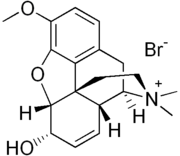Codeine methylbromide
Codeine methylbromide (Eucodin) is the bromomethane (methylbromide) salt of codeine. Its possession is prohibited in many jurisdictions. It is considered a Schedule I controlled substance in the United States, with a DEA ACSCN of 9070 and nil annual aggregate manufacturing quota.[1] as of 2014. As it is used in a different way than basic salts of codeine like the phosphate or hydrochloride owing to its below-mentioned dual action, it is considered to be a different drug related to codeine rather than merely a salt of it in many contexts.[2]
 | |
| Clinical data | |
|---|---|
| Other names | Codeine bromomethylate, 125-27-9, DEA No. 9070 |
| AHFS/Drugs.com | Monograph |
| Legal status | |
| Legal status |
|
| Identifiers | |
IUPAC name
| |
| CAS Number | |
| PubChem CID | |
| ChemSpider | |
| UNII | |
| CompTox Dashboard (EPA) | |
| Chemical and physical data | |
| Formula | C19H24BrNO3 |
| Molar mass | 394.309 g·mol−1 |
| 3D model (JSmol) | |
SMILES
| |
InChI
| |
| | |
Also known by the genericised trade name eucodeine, and the salt name also sometimes given as methobromide, this drug was first synthesised in Austria-Hungary in 1903. As it is a bromide in addition to a codeine salt, it has a dual mechanism of action and is indicated for pain with insomnia or nervousness and violent coughing.[3] This codeine-based bromide also has morphine, dihydrocodeine, dihydromorphine, hydromorphone, isocodeine, hydrocodone, and other such analogues; also, there are codeine-based barbiturates and salicylates.[4]
References
- http://deadiversion.usdoj.gov/quotas/conv_factor/index.html
- <https://books.google.com/books?isbn=1468434446
- <https://books.google.com/books?isbn=1468434446
- Merck Index, 13th Edition, index.